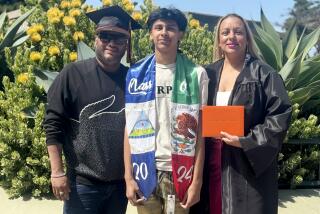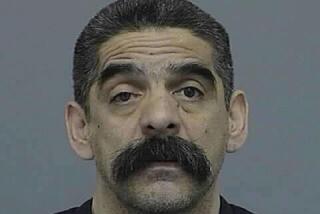Victims’ Family, Friends Left With Pain, Questions
- Share via
The Los Angeles coroner knows Jaime Jaurequi, William Betzner and Eduardo Hurtado as case numbers 2009, 2012 and 2057. The 2,009th, 2,012th and 2,057th people to die at the hands of others in the county this year.
But numbers don’t begin to tell the painful story of a strange 48 hours on the streets of the San Fernando Valley last week, when Los Angeles police shot four men and killed these three.
*
While police and politicians puzzle over the unusually frequent use of deadly force in a short period, the families and friends of the slain men wonder what went wrong with lives filled with as much problems as promise.
Billy Betzner, for one, is missed today in Tarzana.
Three years ago he showed up at the three-horse ranch of a big-band leader with a remarkable admission and a simple request.
I am a murderer, he said, but it was self-defense and I did my time. Will you put me to work?
The band leader, who asked not to be identified, took Betzner in like a stray cat, giving him a place to stay in an old trailer on his one-acre spread a few blocks north of the Ventura Freeway. He only asked the 43-year-old parolee with long blond hair to feed the horses and keep up the grounds--and says he never had a moment’s regret.
“He was a marvelous worker, a fine man, I loved him,” said the musician. “Billy kept to himself, but he did odd jobs for people all over the neighborhood. His parents called me as a reference and thanked me for going to bat for him. They were princes, and so was he.”
But police say Betzner showed them a different side when they allegedly found him rummaging through a construction site a few blocks from home late last Saturday night.
Police say Betzner sped west on Ventura Boulevard with an officer wedged in the cab of Betzner’s El Camino pickup. The officer shot Betzner in the head after traveling two blocks, according to police. Then the truck smashed into a telephone booth and a taco stand where an employee said later he thought an earthquake had upended the building just before midnight.
One of Betzner’s girlfriends delivered the bad news to the band leader Sunday afternoon.
She had been notified in only-in-L.A. fashion.
The girlfriend had paged Betzner on Sunday morning, the band leader said, and got a call back from the coroner’s office. The pager, a coroner’s deputy told her, was attached to an unidentified man in the morgue.
The violent death did not surprise everyone in Betzner’s Tarzana neighborhood.
“I always joked that he looked like a serial killer right out of Central Casting,” said John Schofield, who lives across the street.
Indeed, neighbors learned last week that Betzner had killed two people, not one, in a Reseda barroom brawl a decade ago.
Three bouquets of flowers mark the spot on Ventura Boulevard where Betzner died. They were left, according to witnesses, by a woman who rushed away.
Jaime Jaurequi, too, left a trail of tears when he died that same Saturday night in Northridge from what the coroner’s office calls “multiple gunshot wounds, rapid.”
The 23-year-old car detailer had without doubt skipped out on several traffic warrants in the past, according to family members and police. He had spent time in Juvenile Hall as a youth. And he was driving that day without a license.
But Jaime was really a good guy, his family said. He gave much of his income to his mother for house payments and food, and was en route to pick up a brother when police began tailing him.
Why did he run? Why did police shoot? The questions are tearing at his family.
“He was a boy who just goes to work, comes home, eats, goes to sleep and goes to work again,” said a brother, Alfredo, 18. “I love him a lot. It’s hard losing him.”
Police admit that Jaurequi was not the assault suspect and that he was unarmed. They say he would not have been shot if he had not evaded police and rammed the patrol car.
A police shooting two days later in Canoga Park left holes in more lives.
It was nearly 5 p.m. near Wyandotte Street and Canoga Avenue when bicycle patrol police began to tail a silver Nissan Altima containing four people.
The man behind the wheel, Eduardo Hurtado, appeared to be dawdling through an alley in a melting-pot neighborhood known for illegal drug sales. After another short ride with an officer dangling from a car, Hurtado was shot in the neck.
Yet police found neither drugs nor weapons in the car, which was suspected to have been stolen.
Miles from the West Valley neighborhood, in Simi Valley, Gloria Garcia wept for the dead man, her 28-year-old brother.
“We were totally surprised, it is a great sadness for the whole family,” she said.
Garcia said the car belonged to Hurtado’s girlfriend, and that her brother was a “clean-cut man” who attended Canoga Park High School and now had a 7-year-old son. He had been helping an older brother in his street-cleaning business, she said, while saving money to attend Moorpark College and study electronics.
Rick Hurtado, a brother who sells real estate in Ventura County, said Eduardo had been jailed twice--once for drug possession and once for burglary--but was “a very kind man” who loved children and helped his seven siblings at their homes.
“It’s possible that he was there to buy drugs, but the police shouldn’t kill people because they’re drug users,” Rick Hurtado said. “Nobody deserves what the cop did to my brother.”
No one, however, called the week’s only nonfatal police shooting an injustice.
Eddie Flournoy watched it unfold like a television police drama as he started his shift Monday at Bouchard Communications in North Hollywood.
It was about 6:30 a.m., Flournoy said, when he saw a man later identified as felony parolee Myron Bowers walking south on Klump Street toward Burbank Boulevard.
Police had been called to referee a shouting match between Bowers and his girlfriend outside her apartment in the 5600 block of Klump Street. While Flournoy watched, a patrol car suddenly roared up and parked at a 45-degree angle to Bowers on the street.
He and other witnesses corroborated official accounts of what occurred: that Bowers fired at the police first, and that they reciprocated, wounding him. That Bowers ran, taking one of Flournoy’s supervisors hostage, until tackled by more of Flournoy’s co-workers.
“To see it happen so damn fast was unbelievable,” Flournoy said. “I’m sure if the gun hadn’t misfired both officers would be dead.”
More to Read
Sign up for Essential California
The most important California stories and recommendations in your inbox every morning.
You may occasionally receive promotional content from the Los Angeles Times.










